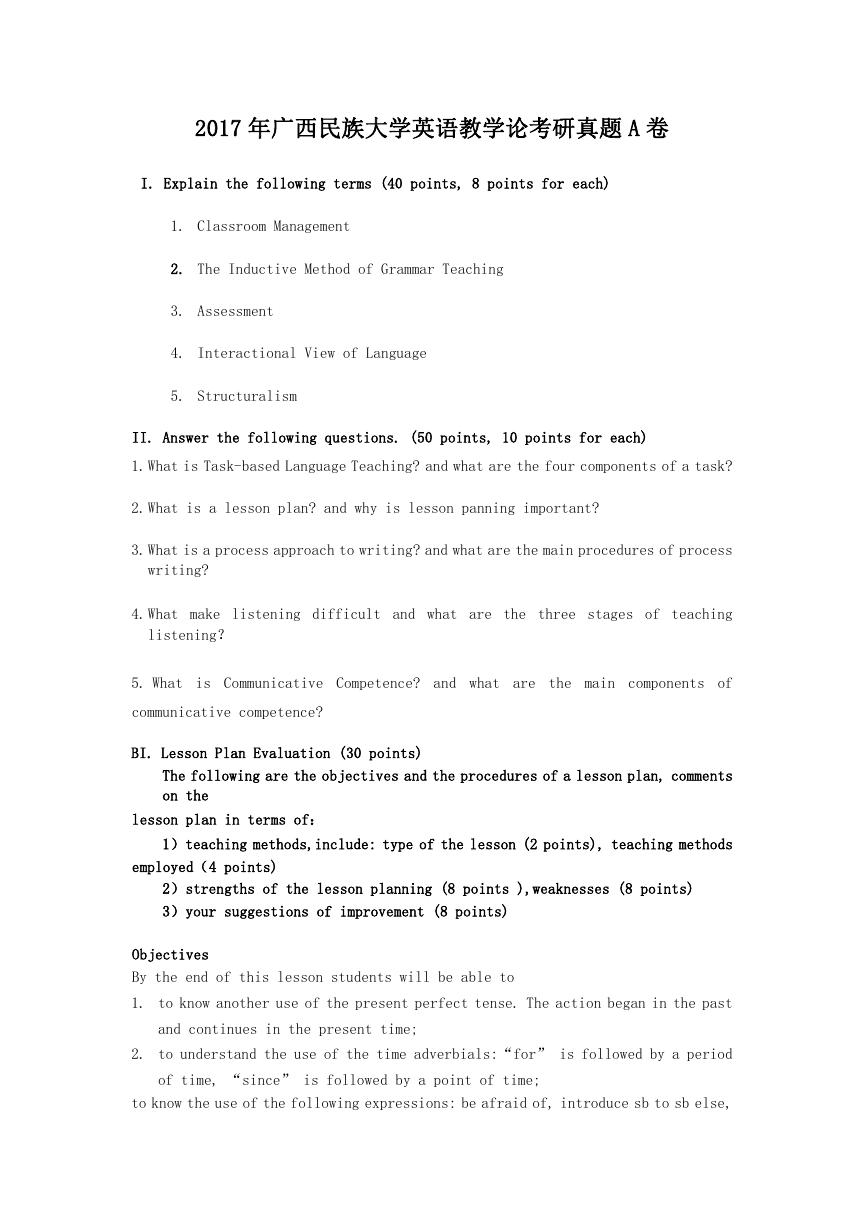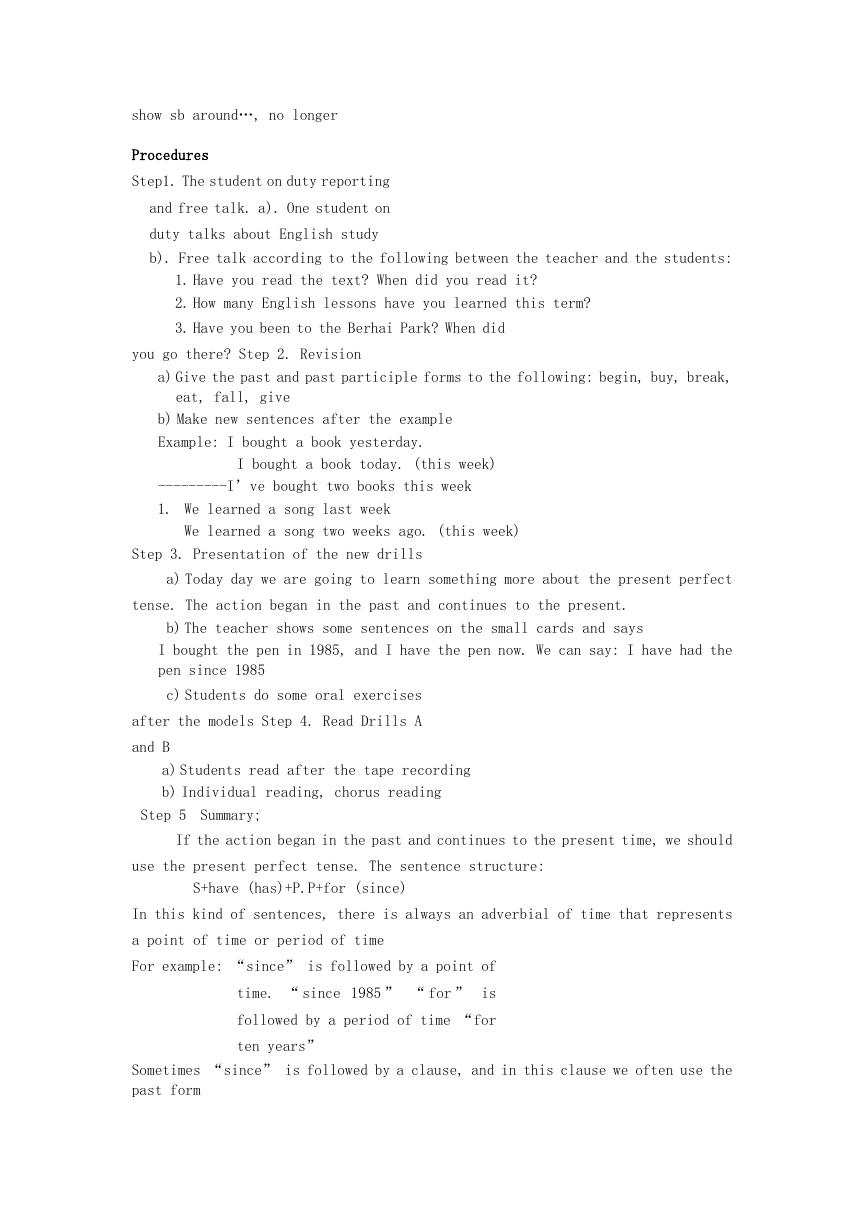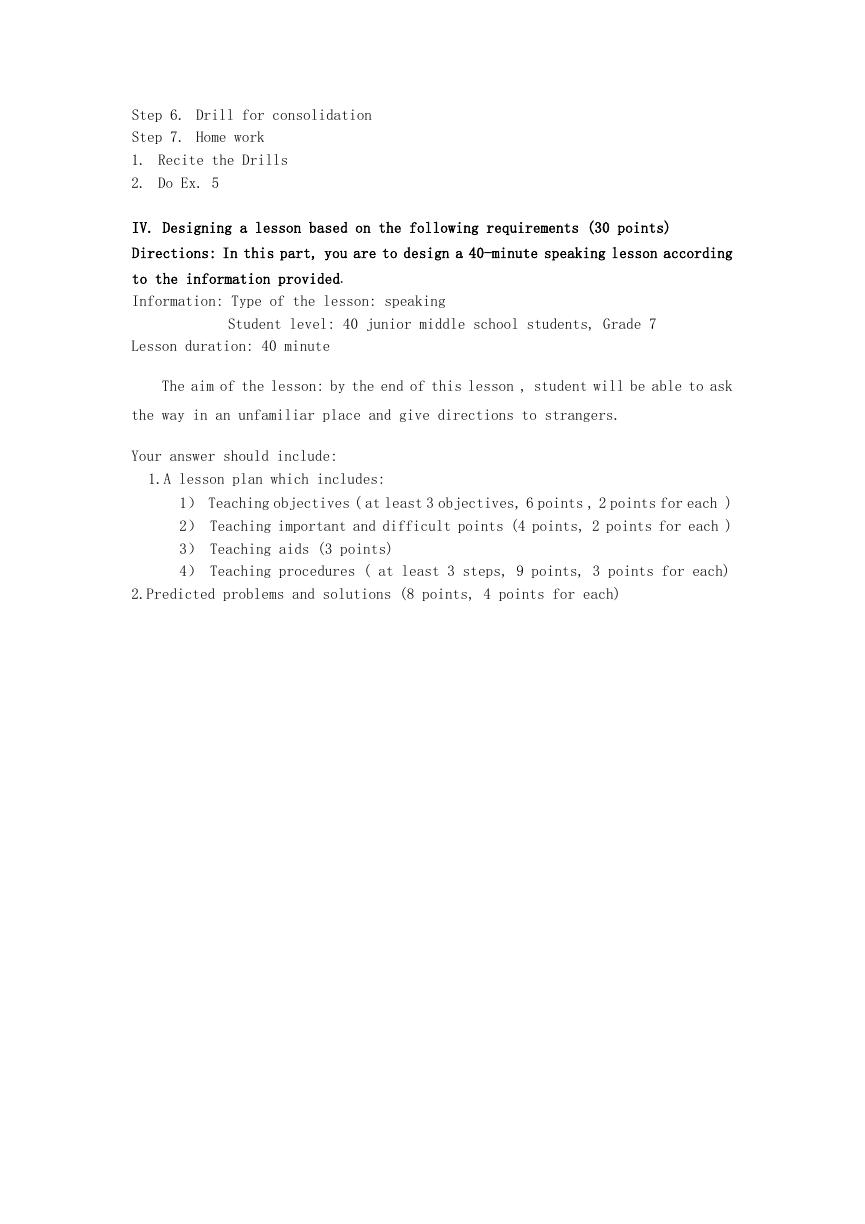2017 年广西民族大学英语教学论考研真题 A 卷
I. Explain the following terms (40 points, 8 points for each)
1. Classroom Management
2. The Inductive Method of Grammar Teaching
3. Assessment
4. Interactional View of Language
5. Structuralism
II. Answer the following questions. (50 points, 10 points for each)
1.What is Task-based Language Teaching? and what are the four components of a task?
2.What is a lesson plan? and why is lesson panning important?
3.What is a process approach to writing? and what are the main procedures of process
writing?
4.What make listening difficult and what are the three stages of teaching
listening?
5. What is Communicative Competence? and what are the main components of
communicative competence?
BI. Lesson Plan Evaluation (30 points)
The following are the objectives and the procedures of a lesson plan, comments
on the
lesson plan in terms of:
1)teaching methods,include: type of the lesson (2 points), teaching methods
employed(4 points)
2)strengths of the lesson planning (8 points ),weaknesses (8 points)
3)your suggestions of improvement (8 points)
Objectives
By the end of this lesson students will be able to
1. to know another use of the present perfect tense. The action began in the past
and continues in the present time;
2. to understand the use of the time adverbials:“for” is followed by a period
of time, “since” is followed by a point of time;
to know the use of the following expressions: be afraid of, introduce sb to sb else,
�
show sb around…, no longer
Procedures
Step1. The student on duty reporting
and free talk. a). One student on
duty talks about English study
b). Free talk according to the following between the teacher and the students:
1. Have you read the text? When did you read it?
2. How many English lessons have you learned this term?
3. Have you been to the Berhai Park? When did
you go there? Step 2. Revision
a) Give the past and past participle forms to the following: begin, buy, break,
eat, fall, give
b) Make new sentences after the example
Example: I bought a book yesterday.
I bought a book today. (this week)
---------I’ve bought two books this week
1. We learned a song last week
We learned a song two weeks ago. (this week)
Step 3. Presentation of the new drills
a) Today day we are going to learn something more about the present perfect
tense. The action began in the past and continues to the present.
b) The teacher shows some sentences on the small cards and says
I bought the pen in 1985, and I have the pen now. We can say: I have had the
pen since 1985
c) Students do some oral exercises
after the models Step 4. Read Drills A
and B
a) Students read after the tape recording
b) Individual reading, chorus reading
Step 5 Summary;
If the action began in the past and continues to the present time, we should
use the present perfect tense. The sentence structure:
S+have (has)+P.P+for (since)
In this kind of sentences, there is always an adverbial of time that represents
a point of time or period of time
For example: “since” is followed by a point of
time. “ since 1985 ” “ for ” is
followed by a period of time “for
ten years”
Sometimes “since” is followed by a clause, and in this clause we often use the
past form
�
Step 6. Drill for consolidation
Step 7. Home work
1. Recite the Drills
2. Do Ex. 5
IV. Designing a lesson based on the following requirements (30 points)
Directions: In this part, you are to design a 40-minute speaking lesson according
to the information provided.
Information: Type of the lesson: speaking
Student level: 40 junior middle school students, Grade 7
Lesson duration: 40 minute
The aim of the lesson: by the end of this lesson , student will be able to ask
the way in an unfamiliar place and give directions to strangers.
Your answer should include:
1.A lesson plan which includes:
1) Teaching objectives ( at least 3 objectives, 6 points , 2 points for each )
2) Teaching important and difficult points (4 points, 2 points for each )
3) Teaching aids (3 points)
4) Teaching procedures ( at least 3 steps, 9 points, 3 points for each)
2.Predicted problems and solutions (8 points, 4 points for each)
�






 2023年江西萍乡中考道德与法治真题及答案.doc
2023年江西萍乡中考道德与法治真题及答案.doc 2012年重庆南川中考生物真题及答案.doc
2012年重庆南川中考生物真题及答案.doc 2013年江西师范大学地理学综合及文艺理论基础考研真题.doc
2013年江西师范大学地理学综合及文艺理论基础考研真题.doc 2020年四川甘孜小升初语文真题及答案I卷.doc
2020年四川甘孜小升初语文真题及答案I卷.doc 2020年注册岩土工程师专业基础考试真题及答案.doc
2020年注册岩土工程师专业基础考试真题及答案.doc 2023-2024学年福建省厦门市九年级上学期数学月考试题及答案.doc
2023-2024学年福建省厦门市九年级上学期数学月考试题及答案.doc 2021-2022学年辽宁省沈阳市大东区九年级上学期语文期末试题及答案.doc
2021-2022学年辽宁省沈阳市大东区九年级上学期语文期末试题及答案.doc 2022-2023学年北京东城区初三第一学期物理期末试卷及答案.doc
2022-2023学年北京东城区初三第一学期物理期末试卷及答案.doc 2018上半年江西教师资格初中地理学科知识与教学能力真题及答案.doc
2018上半年江西教师资格初中地理学科知识与教学能力真题及答案.doc 2012年河北国家公务员申论考试真题及答案-省级.doc
2012年河北国家公务员申论考试真题及答案-省级.doc 2020-2021学年江苏省扬州市江都区邵樊片九年级上学期数学第一次质量检测试题及答案.doc
2020-2021学年江苏省扬州市江都区邵樊片九年级上学期数学第一次质量检测试题及答案.doc 2022下半年黑龙江教师资格证中学综合素质真题及答案.doc
2022下半年黑龙江教师资格证中学综合素质真题及答案.doc